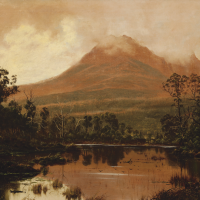58. HAUGHTON FORREST

Mount Pelion, the third highest mountain in Tasmania, is located in the central highlands and is part of the Pelion range within the Cradle Mountain-Lake St Clair National Park. On the northern side of the mountain, Forth River flows down towards Frog Flats. The present work, View of Mount Pelion West from Frog Flats, Tasmania, depicts the view from the northern side of Mount Pelion, across Frog Flats, in some of Tasmanias most well-preserved and unique wilderness.
The trail which passes through this isolated area of Tasmania is called the Overland Track, a famous sixty five kilometre trek which begins at Cradle Mountain and terminates at Lake St Clair. Even today with the modern conveniences which are available along the track, the journey is an arduous one. Due to the difficulty in accessing these remarkable pockets of Tasmania, Haughton Forrest would often refer to the photographic work of James Watt Beattie (1845-1930) who trekked into the Tasmanian wilderness to photograph the spectacular natural environment. These photographs assisted Forrest to portray a level of detail in his own work and to create images of Tasmania that were unfamiliar to the general public.
Haughton Forrest arrived in Tasmania at the age of fifty after a lifetime of travelling the world, first with his parents and later with his own family. He was born in France in 1826 and later travelled throughout France and Germany before returning to the family home in Berkshire, England. Soon after, the Forrest family spent time in Jamaica where his father owned sugar plantations and from there, the artist went on to attend military college in Wiesbaden, Germany. Forrest went on to the 31st Royal Monmouth Light Infantry where he earnt the rank of Captain. In 1858 he married his wife, Susan, and settled in southern England after time spent living on the Isle of Wight. Forrest moved to southern Brazil in 1875 to take up a grant of sixty acres but found the conditions difficult and returned to London. The following year he boarded the James McDuff with his family and set sail for Tasmania where he remained until his death in 1925.
Forrest is most well-known as a marine painter however his photo-realist landscapes of Tasmania arguably represent his best work. His painting is characterised by the extraordinary detail and precise brushwork together with the subtle treatment of light which permeates his compositions. View of Mount Pelion West from Frog Flats, Tasmania possesses an almost photographic quality in its finely painted detail the trees and shrubs around the waterline are depicted with such accuracy that they take on a life-like quality upon the canvas. Forrests ability to capture the light of early morning/early evening is testament to his skill as a landscape painter. The depiction of light is crucial to the success of landscape painting and the present work demonstrates the artists great capability in
this regard.
Caroline Jones MA (Art Admin.)